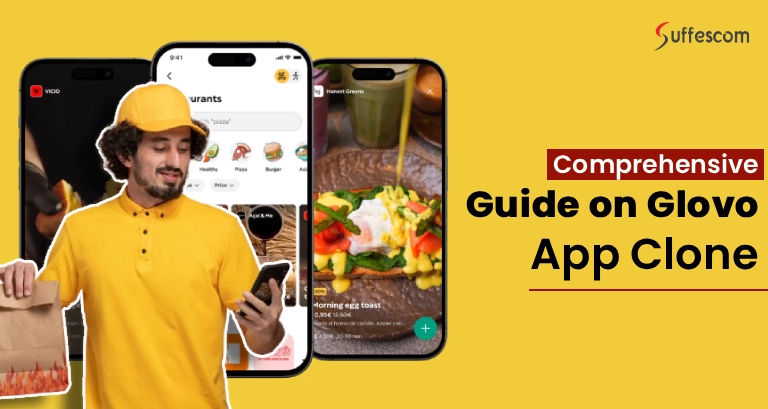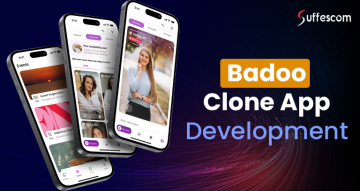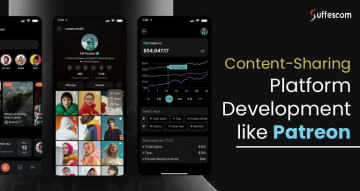Glovo App Clone: Features, Security, and Growth - Comprehensive Guide

The on-demand delivery business is one of the global industries that has been developing and evolving at an outstanding rate because of convenience and digital-first lifestyles. Most of the traditional on demand food and courier delivery businesses are always looking at how they can penetrate this space with cost-effective, scalable, and feature-rich solutions. At Suffescom we apply an effective strategy to develop Glovo clone.
This guide gives a closer examination of the key functionalities, premium features, security systems, deployment tactics, and growth options of these apps. We shall also look into the income models, the technological stack, and why a Glovo clone can be a strategic advantage to the entrepreneurs and enterprises in the delivery ecosystem.
Core Functionalities of Glovo Like On-Demand Delivery App
A deliverable on-demand app needs to copy the core user experience that avenues seek and a seamless functionality of the drivers, stores, and administrators. Some of the main functionalities that are the core of a Glovo clone app are:
1. User Registration & Profiles
- It is easy for customers, drivers, and stores to sign up via email, phone number, or social media services.
- Profile management involves the updating of personal information, payment preferences, and addresses.
2. Search & Discovery
- A powerful search tool will enable the user to find a restaurant, grocery store, pharmacy, or any other service provider within a short period of time.
- Browsing is easy because of filters and categories that allow shoppers to find something new or that is trending.
3. Order Placement
- The user interface is friendly, whereby a customer can add items to their cart by clicking just a few times.
- Offers, coupons, and discounts can be used at checkout to have a seamless and rewarding experience.
4. Payment Gateway Integration
- Various safe payment options, including debit/credit cards, digital e-wallets, and 3rd party gateways, make it flexible.
- Safe and effortless payments are ensured by encrypted transactions.
5. Order Management
- Orders will be instantly placed to stores so they can be accepted, prepared, and status updated in real time.
- Notifications inform drivers and customers about the status of an order.
6. Driver Matching
- A smart algorithm will automatically assign the closest available driver.
- This is less waiting, and it makes deliveries quicker.
7. Delivery Tracking
- Customers are able to have line-of-sight mapping of the delivery route in real-time via a GPS-enabled map.
- Transparency and less uncertainty are provided by real-time updates.
8. Ratings & Reviews
- Customers can also rate their experience and leave feedback after a successful order completion.
- Reviews assist in stabilizing the quality of services and fostering the trust of people.
All of these functionalities are integrated to compose an efficient, error-free, and captivating delivery environment. The efficiency, security, and convenience they provide form the basis of an excellent on-demand delivery experience that can be beneficial to all the stakeholders.
Transform Your Vision into a Customized and Market-ready Glovo App Clone
How to Build an App Like Glovo: Step-by-Step Development Approach
The strategy of the Glovo app development must be well-planned to merge technology, business orientation, and usability. The route of development can be split into a number of key steps:
1. Market Research and Business Planning
Analyze your target market, competitors, and delivery requirements in the region before you begin development. Decide what you want to specialize in: food, groceries, medicines, or a multi-service marketplace. A good business model will assist you in finding out the unique value proposition of your app.
2. Feature Planning and Wireframing
Write down what features you absolutely have to have, like registration, search, payments, and tracking. Create wireframes or prototypes to visualize user flows to customers, drivers, and stores. Planning ahead will make the implementation of high-end functions in the future much easier.
3. Choosing the Tech Stack
Select a scalable technology stack. Popular choices include:
1. Frontend: React Native, Swift, or Kotlin
2. Backend: Node.js, Laravel, or Django
3. Database: MongoDB, MySQL, or PostgreSQL
4. Cloud Infrastructure: AWS, Google Cloud, or Azure
This combination ensures reliability, scalability, and speed.
4. MVP Development and Testing
Start with a Minimum Viable Product (MVP) that has the main functions. Nimble launches allow the harnessing of actual user feedback to cut down on expenses. Careful cross-device testing will also keep performance smooth and security compliant.
5. Full-Scale Deployment and Support
Once the MVP is proven, introduce new complexities into the app, including AI-powered suggestions, loyalty systems, and more languages. Launch the app on Android and iOS platforms and have a powerful backend infrastructure. Maintenance, bug fixes, and updates are essential in long-term development.
6. Marketing and Growth Strategies
Utilise digital marketing, referral programs, and strategic partnerships with local businesses to acquire users. A robust post-launch expansion strategy is a must to expand operations.
Premium Add-Ons That Make Your Glovo Clone Stand Out
The contemporary competitive on-demand delivery industry demands more than core features to attract users. Businesses must introduce the premium add-ons that raise customer satisfaction and give them an advantage over the generic delivery apps. Some of the most influential advanced integrations in a Glovo clone are given below:
1. AI-Powered Recommendations
- Artificial Intelligence scans down on customer behavior, past orders, and preferences.
- Suggests personalized recommendations to enhance user interaction and order value.
2. Loyalty Programs & Memberships
- Helps in retaining its customers through awarding them reward points, special discounts, or cash back.
- Subscriptions have unlimited or discounted delivery, including monthly memberships.
3. Multi-Payment Wallets
- In-wallets enable the customers to save balance, get refunds, and redeem rewards.
- Increases flexibility by incorporating several payment systems.
4. Voice Search & Smart Ordering
- Makes access more approachable because the user can order via voice.
- Decreases ordering time and eases the process for busy customers.
5. Delivery Scheduling
- Enables pre-booking of deliveries at pre-determined hours.
- Handy in terms of grocery or meal planning, timely and organized service.
6. Contactless Deliveries
- Offers safety in terms of QR-based confirmation or doorstep deliveries.
- Critical to health-savvy clientele as well as the post-pandemic delivery patterns.
These extras lie beyond functionality, thus providing the user with an enhanced experience with plenty of chances for businesses to retain their customers and grow in revenue in the process. The incorporation of these features makes a Glovo clone not only ultra-competitive but also one that can serve both the service providers and users in the long run.
Ensuring Security in Glovo Clone Apps: Key Safety Features
The basis of any digital commerce platform, and in on-demand delivery services like a Glovo clone script in particular, is security. A robust security structure not only safeguards confidential user information, but it also provides a free flow of business processes. The following are the default security layers incorporated in a strong Glovo clone script:
1. End-to-End Encryption
- Ensures that personal data, financial information, and the communication of users and the site are secure.
- Information is encrypted at the device of the sender up to the receiver and cannot be intercepted.
2. Secure Authentication
- Several authentication options (e.g., OTP verification, biometric authentication (fingerprint/face ID), or multi-factor authentication (MFA)).
- Adds an additional security measure against unauthorized access to accounts.
3. Fraud Detection Systems
- Artificial Intelligence is used to monitor abnormal or suspicious activity.
- Assists in the prevention of fraud, account takeovers, or payment tampering.
4. GDPR & Compliance Standards
- Ensures the platform is compliant with worldwide data privacy regulations such as GDPR
- Holds the rights of customers and creates a legal framework related to the processing of user information in a secure manner.
5. Encrypted Wallets & Payment Gateways
- The in-app wallets and payment gateways are encrypted to prevent unauthorized access.
- It minimizes the threat of leaking financial data and exposes the users to cyberattacks.
6. Building Trust Through Security
- A secure platform eliminates losses in finances, minimizes cyberattack risks, and establishes a safe environment for users.
- The layers of security will increase the confidence of the user, resulting in long customer loyalty and brand reputation.
Contactless Deliveries and Flexible Pickup Options Offered
The trend in modern consumerism has changed greatly, and safety and flexibility have become key components in the platform of delivery. A Glovo-type application satisfies these requirements because of its innovative features that provide convenience and security at the same time:
1. Zero-Contact Deliveries
- Couriers leave the order at the doorstep of the customer.
- Reduces face-to-face interaction and makes it safe, particularly when people are more sensitive to health risks.
2. Scheduled Pickups
- Customers are able to choose a definite time slot to receive the orders.
- Gives flexibility to busy users who like to plan delivery.
3. Curbside Pickups
- Curbside pickup entails customers picking up their orders at the retail stores.
- Ensures swift transactions with very little contact.
4. QR-Based Confirmations
- Confirmation of delivery is arrived at by scanning a QR code.
- Guaranteed, verified deliveries are more foolproof and have less potential for errors or fraud.
5. Customer-Centric Approach
- The characteristics are meant to suit different customer tastes.
- The app offers the best solution to users who prefer their safety and comfort, or the management of time.
Advanced Glovo App Clone: Run Delivery Business in Couple Of Days
Four User Panels: Admin, Customer, Driver & Store Roles
To allow flawless functions and coordination, a Clone App Development framework is usually engineered through a combination of four panels. All panels have their specific purpose and create an open and streamlined environment altogether.
1. Admin Panel
- Acts as the centralized control unit of the whole platform.
- Does user, driver, store, delivery, and payment management.
- Offers elaborate analysis and information to track performance and streamline operations.
2. Customer Panel
- The mobile app can enable easy ordering.
- Activities offered are product browsing, making orders, viewing real-time deliveries, and posting reviews.
- Specialized in providing convenience and improving customer experience.
3. Driver Panel
- Customized for delivery personnel in order to streamline their activities.
- Has driving directions, delivery status, and pay tracking
- Makes on-time deliveries and open communication with both the customers and the administration.
4. Store Panel
- Helps stores or restaurants to present goods and change stock levels.
- Automates orders management, processing, and status changes.
- Streamlines the processes of vendors connecting to customers and drivers.
Real-Time Tracking, Multilingual Support, and Push Alerts
To offer a modern on-demand delivery, one will need sophisticated engagement and accessibility features:
1. Real-Time Tracking – GPS-based maps depict the real-time position of the driver.
2. Multilingual Support – Multilingual support widens its reach to the global market.
3. Push Alerts & Notifications – Keeps users informed on orders, offers, and service updates.
4. Smart Analytics – Statistics of the administrators to adjust operations.
These integrations enhance user interactions and platform productivity.
Building Your Revenue Model: Fees, Commissions & Ads
The sustainability of a delivery platform depends on well-defined revenue streams. A Glovo-style app typically leverages multiple monetization models:
1. Delivery Charges – The clients pay normal fees or surge charges per delivery
2. Commissions – Restaurants and shops have a percentage share.
3. Subscription Plans – Meg-written subscription at the annual rate of 100 rivers or extra.
4. Advertising – Stores pay to be better seen on the app.
5. In-App Wallets – Help build loyalty with the amount of stored balance and cashback.
These revenue models may be customized accordingly, as per the target audience and the objective of the business.
Launching Fast: Deployment Time, Tech Stack, and Support
Time-to-market in the delivery sector is very instrumental as a determining factor of success. When done well, a deployment strategy can position a business to launch faster, reduce downtime, and enable scale. These key elements of an optimized deployment process are as follows:
1. MVP App Development
- Start with a Minimal Viable Product (MVP) with only the core features such as user registration, order placement, delivery tracking, and payments.
- This model enables companies to very rapidly put a product on the market and test the demand, collect user feedback, and iterate on the product prior to committing to complete development.
2. Scalable Tech Stack
- Making the right choice in terms of technology will guarantee good performance and long-term development.
- The most popular frameworks and languages to use are Node.js on the backend, React Native to provide cross-platform mobile applications, Kotlin and Swift to do native Android and iOS applications, and MongoDB as a flexible database tool.
- A scalable stack can be used to easily add features without impacting the workload.
3. Cloud Infrastructure
- Using reputable cloud providers, such as AWS, Google Cloud, or Azure datacenters to host, guarantees security, adaptability, and a good record of uptime.
- Cloud-based, it can provide load balancing and data back-ups as well as disaster recovery to ensure continuous service.
4. Deployment Timeline
- The development process takes 4 to 6 months, depending on features and the complexity of development.
- A visual approval process shows and demonstrates defined milestones and prevents costly delays.
5. Ongoing Support
- It is important to make post-deployment updates and bug fixes, and release new features.
- Customer support systems are used to eliminate user problems, so as to improve customer satisfaction and retention.
Why Choose a Glovo Clone? Benefits for Businesses & Users
Deciding on an investment in a delivery platform can be seen as a strategic process. Companies always have decisions to make, whether it is better to construct a brand new business or use a Glovo clone. The latter has numerous benefits:
1. Cost-Effective – Can save the cost of delivery app development when compared to custom development.
2. Faster Time-to-Market – Boosts in time-to-market.
3. Customizable Features – You can customize to fit the unique needs of your market.
4. Scalability – Designed in a modular way to allow future expansion.
5. Proven Business Model – Replicates a proven model of a delivery ecosystem.
On behalf of the user, the advantage is that it offers smooth journeys, secure payments, real-time information, and multiple services via a single app.
Conclusion
The proliferation of on-demand delivery has presented unprecedented potential for businesses. A Glovo clone has conventional features with flexible customizations that treat various user needs. Using well-grounded security, deliveries without contact, supporting provision across multiple languages, and using a clear revenue model, entrepreneurs can start in the market confidently.
The appropriate on demand mobile app development strategy supported by an experienced staff and technology that can scale in the long term will be the guarantee of success. Companies that have implemented such a model eliminate operational hurdles and also enjoy a competitive advantage in the emerging delivery economy.
FAQs
Q1. What is a Glovo clone and how does it work?
A Glovo clone is a readymade delivery application with customizable add-ons that will recreate the basic functionality of Glovo. It bridges customers to the store and delivery drivers, combined with real-time tracking, ordering, and payments.
Q2. How secure are Glovo clone apps for transactions?
They arrive with end-to-end encryption, secure authentication, and fraud detection technologies to safeguard the user information and monetary transactions.
Q3. What is the average time required to launch a Glovo clone?
Depending on features and integrations, deployment usually takes between 4 and 6 months, with MVP options allowing faster launches.
Q4. Can the Glovo clone be customized for different business models?
Yes, it can be altered to include delivery of food, groceries, drugs, and even multi-service marketplaces.
Q5. How do Glovo clones generate revenue?
They make their money on commission, delivery costs, subscription-based platforms, adverts on their inside app, and featured shop products.
Q6. Why is multilingual support important in a delivery app?
It enables companies to go global, capture a wide range of users, and provide a more customized experience.







